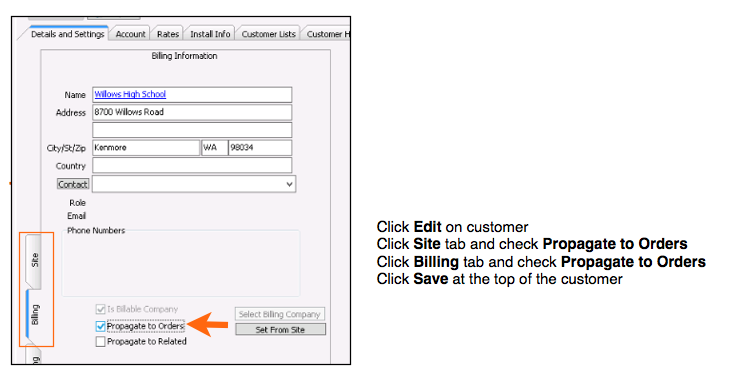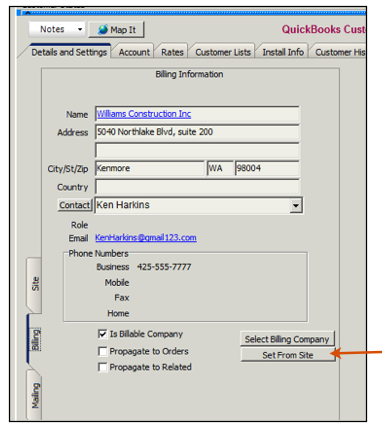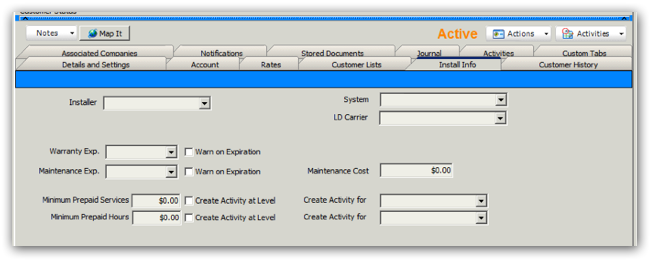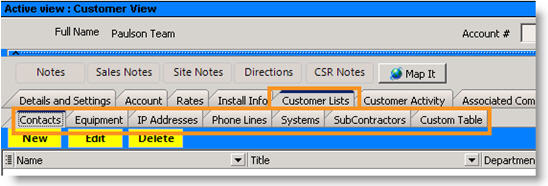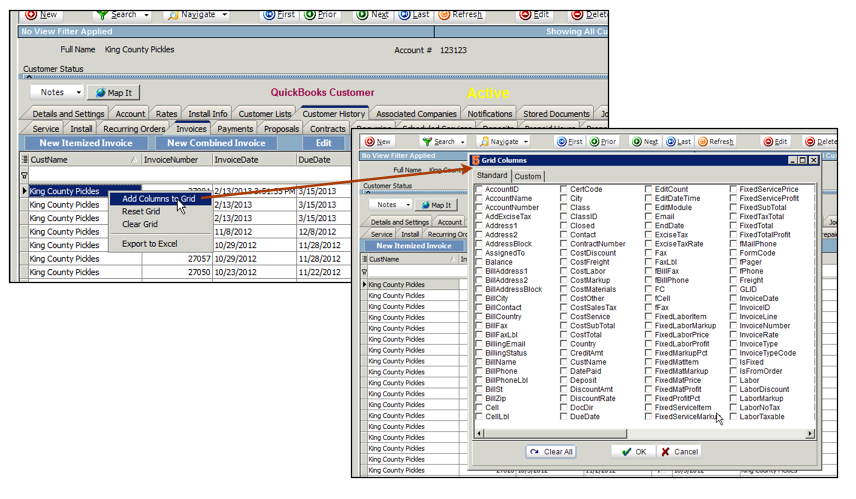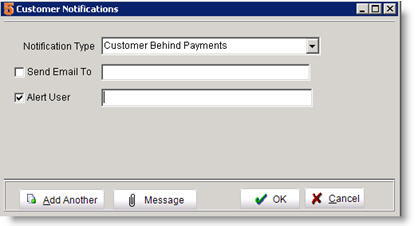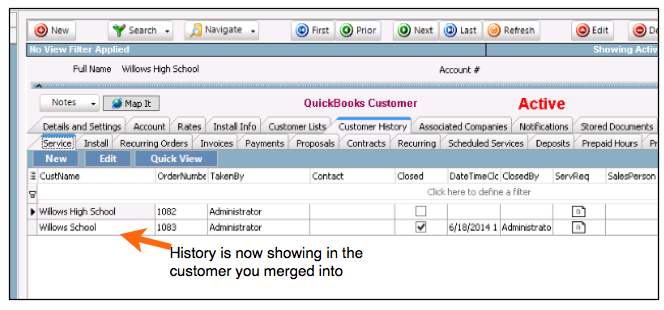Difference between revisions of "Customers"
| Line 79: | Line 79: | ||
<br>[[File:Propagate_SingleUserMode.png]] | <br>[[File:Propagate_SingleUserMode.png]] | ||
| + | <h3>Mailing Tab</h3> | ||
| + | If you fill out an address on the Mailing tab and check Use on Invoices, then on any invoice created for that customer, the mailing address will populate the Site tab. | ||
| + | <br>[[File:MailingTab_UseOnInvoices.png]] | ||
| + | |||
| + | <br>When a work order is invoiced, the Site tab shows the info from the Mailing tab because '''use on invoice''' is checked. | ||
| + | <br>[[File:MailingTab_showOnInvoiceSiteTab.png]] | ||
<h3>Fields in the Customer Record - Details and Settings tab</h3> | <h3>Fields in the Customer Record - Details and Settings tab</h3> | ||
Revision as of 23:35, 24 July 2014
<videoflash>Ybxk061nD60</videoflash>
There are a couple ways to create a new customer.
- Select New > Customer.
- The Customer module will open with an empty customer record.
- Fill out the record and click Save
Another way to create a new customer:
- Select the Customer module.
- Click New.
Details and Settings Tab
On this tab, you can track the site, billing and mailing address using the tabs along the left. All of these addresses can be the same or they could all be different.
If the site, billing and mailing information is the same:
- Fill out the Site tab with the company and address information.
- Select the Billing tab.
- Click Set From Site (arrow in image below)
- The address from the Site tab will populate the Billing tab.
- Select the Mailing tab.
- Click Set From Site.
- The address from the Site tab will populate the Mailing tab.
In some cases you may have one customer you are working with and you have multiple job sites for them. You can create a parent child relationship. If you do this, you could look up the parent company and find all of the related “child” companies.
To create a parent – child company structure:
First, create a company record for the “parent” company. Usually the information on the Site and Billing tab for the parent is going to be the same. When that is created, you can then create the "child".
- Create a company record for the “child” company.
- On the Site tab, enter the job site information.
- In the “child” record, select the Billing tab.
- Click Select Billing Company.
- In the window that displays, select the billing or “parent” company.
- Click Save in the "child" company record.
- Notice the Full Name for the “child” company.
To see all “child’ companies for the “parent” company
- Select the “parent” company.
- Select the Associated Companies tab.
- All related “child” companies will be listed.
To add a contact to a company record
- Click your cursor in the Contact field.
- Type the contact name.
- Tab to the next field and the Contact Editor will display. (image below)
- Fill out the contact information.
- Click OK.
Syncing Customer to QB
Review the SQLink page to determine the best settings for syncing customer names from SME to QB Company and Customer name fields.
http://high5software.com/mediawiki/index.php?title=SQLink#Billing_Name_Options
Phone Number syncing to QB Company
When entering a new customer in SME, the first and third phone number fields sync to QuickBooks Phone and FAX phone numbers as shown in the image below. Even if you change the phone label in SME, it still will sync the first and third phone number fields.
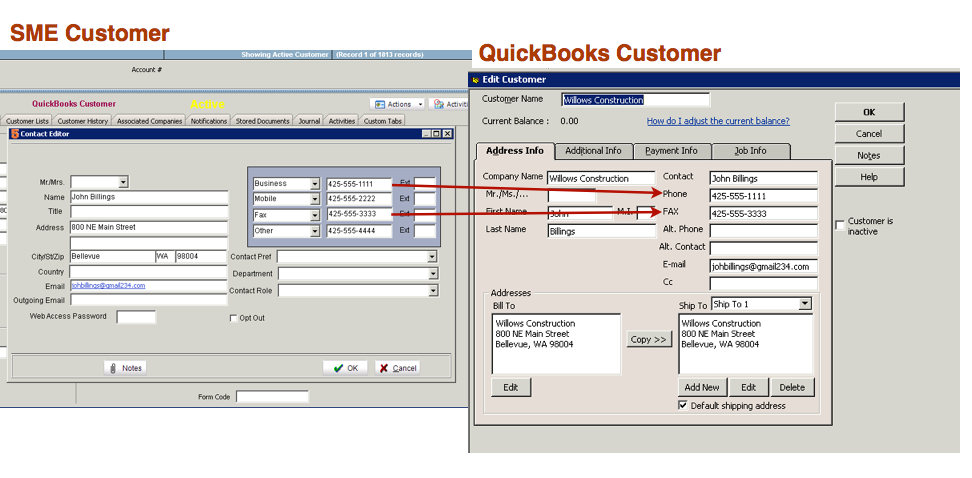
Leaving Site Address Blank
If you leave the Site Address blank in SME, after your sync with QuickBooks, the billing address will populate the site tab. To keep the billing address out of the site tab, put a "." in the address1 field on the site tab.
click here for screenshots: http://high5software.com/mediawiki/index.php?title=SQLink_FAQ#Customer_Site_Address_is_populating_with_Billing_Address_After_Sync
Edits to SME Customers syncing to QB
If you edit a customer in SME, the customer will be set to sync to QB on the next sync. You will see the Export to QB flag checked. Once synced, the flag will be cleared.
Updating Site and Billing Address in SME
To update existing open orders and open invoices with the new address, all other users must be logged out of SME. Then you can check Propagate and save the customer.
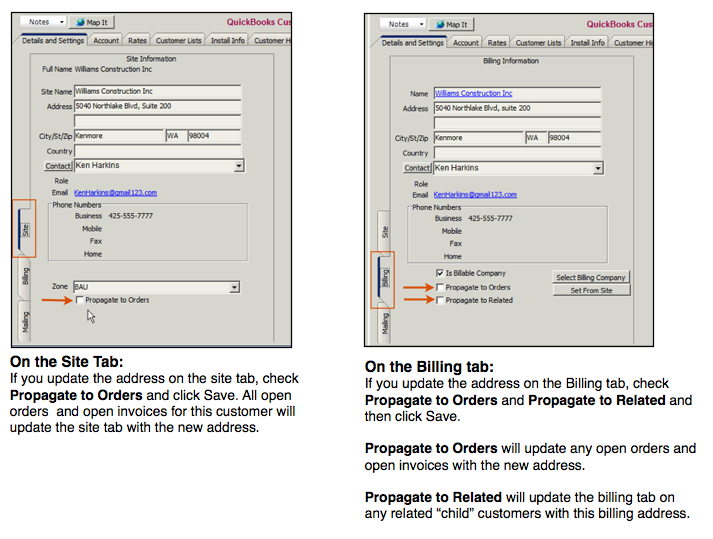
If other users aren't logged out of SME, the you will get this message:

Mailing Tab
If you fill out an address on the Mailing tab and check Use on Invoices, then on any invoice created for that customer, the mailing address will populate the Site tab.
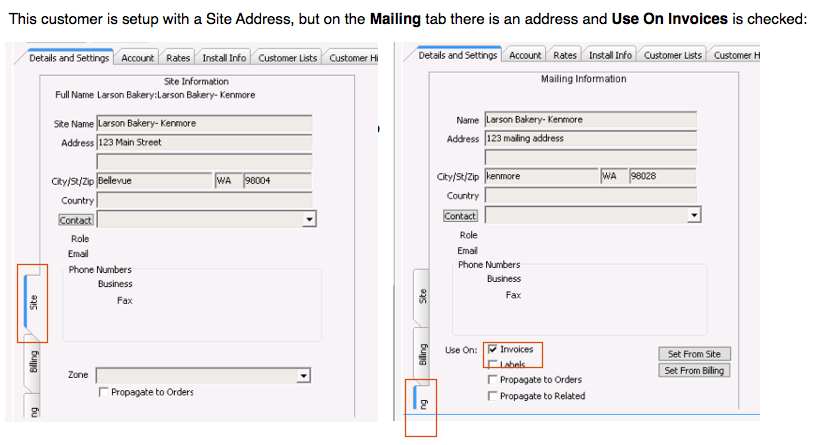
When a work order is invoiced, the Site tab shows the info from the Mailing tab because use on invoice is checked.
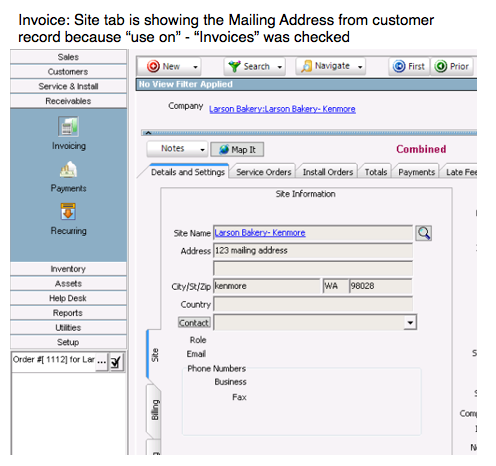
Fields in the Customer Record - Details and Settings tab
Account # - Based on the settings your SME Administrator setup, this field is auto populated when you save the company record.
Balance - Displays the amount due for all open invoices for the customer. This is a calculation and it is not an editable field. If you have parent/child customer structure, the child/site customer balance is added to the parent balance and the child balance is 0.00
Salesperson - Select from the salesperson in the Salesperson drop down. The names in this drop down are determined by your SME Administrator.
Division - The drop down can be customized by your SME Administrator. Once you collect this information for your customers, you can sort your customers by division.
Status - This is a text field to type a quick message that is visible here on the Details and Settings tab.
URL - Type the customers website address
Location - Warehouse location for customer equipment in your warehouse.
- Here is information about Customer Warhouses: http://high5software.com/mediawiki/index.php?title=Warehouses#Customer_Warehouses
Messages - The messages box contains a list of emailed notifications, as well as calculated data based on current information. For example if account is past due, if maintenance/warranty has expired, when the next activity is scheduled for the customer, etc. Clearing the message clears the notification messages, but the calculated messages are always there.
Account Tab
On this tab you will find your customer’s account information. Depending on the permissions set by your SME Administrator, this tab may be hidden from view. At the bottom of the tab, find the customer’s balance due.
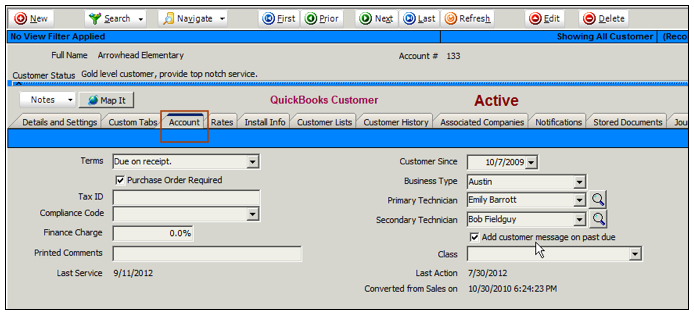
|
Terms |
Select the default billing terms for the customer. When creating an invoice, you can always change the terms. |
|
Purchase Order Required |
If checked, any service or install order created for the customer will require a PO# to be entered on the order. |
|
Tax ID |
Type in the customers Tax ID |
|
Finance Charge |
Enter the finance charge. Click Late Fees / Finance Charges for more information |
|
Source |
Enter the source of this customer |
|
Printed Comments |
If this field is on a report, the text typed in the field will display on the report (e.g. invoice, orders) |
|
Last Service |
Date populated based on the latest Date Opened field on the companies work orders. The Date Opened field is auto-populated with the date you created the order, but it can be changed. |
|
Customer Since |
The date field is auto-populated with the date you created the company record. You can change the date as necessary. |
|
Business Type |
You can select the type of business. This drop down list can be customized by your SME Administrator. |
|
Business Hours |
As a reference, type the business hours. |
|
Primary Technician |
When you add labor to an order for this company, the primary technician will populate the Technician field on the Labor Editor. You can select another technician in the Labor Editor as needed. |
|
Secondary Technician |
Select a secondary technician. In an order for the customer, you can reference the secondary technician field. |
|
Add Customer Message on Past Due |
The following message will populate the message field on Details and Settings tab: “Account is past due” |
|
Class |
If you are syncing SME with QuickBooks, this drop down should match your Class list in QuickBooks. |
|
Converted from Sales on |
Auto-populated date showing when you converted the company from a Lead to a Customer. No date will display if the company was created directly in the customer module. This date cannot be edited. |
At the bottom of the Account tab, you will see balance information. If you don't see this, then it was hidden based on your User Group settings.
![]()
Net 30, Net 60, Net 90 - These field shows balances that are 30, 60 or 90 days past the due date
The due date for account calculations can be based on the Invoice Due Date or on the Invoice Date. This is determined by your setting in Setup > Company > System. The setting is Base Past Due on Invoice Date, not Due Date.
Deposit on Account - This shows the total deposits entered for a customer in SME. SME Deposits stay in SME and do not sync to QuickBooks.
Rates Tab
The rates tab is where you can set up special pricing for the customer and tax information.
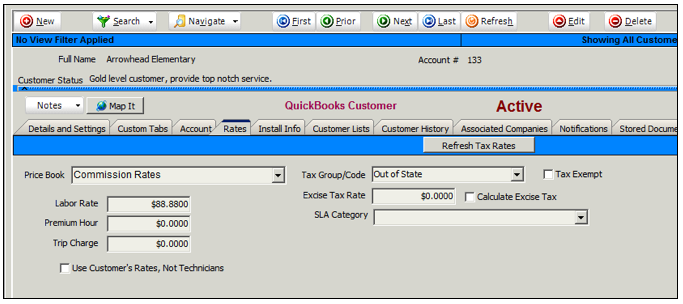
|
Price Book |
Select the price book for the customer here and all pricing on orders will be based on the rules set up in the price book. |
|
Premium Hour |
Enter an amount you want to charge the customer for every order. It will show in the Premium field on the Totals tab in the order. |
|
Trip Charge |
Enter the trip charge amount you want to populate every order for the customer. It will show in the Trip Charge field on the Totals tab in the order. |
|
Tax Group/Code |
Select the appropriate tax group for the customer. Your SME Administrator will set these up based on your needs. |
|
Tax Exempt |
Check for your tax exempt customers. |
|
Excise Tax Rate |
Enter the excise tax rate. **NOTE** In order for this tax to be calculated on an order, your SME Administrator must check “Apply Excise Tax” in the Setup module > Company > Order . |
|
Calculate Excise Tax |
Check here for SME to calculate the Excise Tax on orders |
|
SLA Category |
Set SLA Category for your customer. Any order or itemized invoice you create for the customer will have the SLA category on the record. SLA Category |
Install Info Tab
This tab gives you an overview of the customer site. You may have individual maintenance contracts for the customer as well.
|
Installer |
Technician that did the install |
|
Warranty Exp. |
Set the date for warranty expiration. If “Warn on Expiration” is checked and it is past the date, the following message will populate the message field on Details and Settings: “Warranty expired: x/x/20xx” |
|
Maintenance Exp. |
Set the date for maintenance expiration. If “Warn on Expiration” is checked and it is past the date, the following message will populate the message field on Details and Settings: “Maintenance expired: x/x/20xx” |
|
Minimum Prepaid Services |
Set the minimum prepaid services required for this customer. SME will compare the amount here to the amount entered on Customer Activity tab > Prepaid Services. When below the minimum level, the following message will populate the message field on Details and Settings: “Minimum level of prepaid services reached x/x/20xx” |
|
Minimum Prepaid Hours |
Set the minimum prepaid hours required for this customer. SME will compare the amount here to the amount entered on Customer Activity tab > Prepaid Hours. When below the minimum level, the following message will populate the message field on Details and Settings: “Minimum level of prepaid hours reached x/xx/20xx” |
|
System |
Your SME Administrator may have customized this field. Choose the system associated with this customer. |
|
LD Carrier |
Long Distance Carrier |
|
Maintenance Costs |
Type the maintenance cost for the customer. This is not linked to a maintenance contract. |
Customer Lists Tab
The Customer Lists tab provides access to more tabs. Here you can access all contacts related to the customer and a list of the customer equipment.
If you aren't seeing all these tabs under Customer Lists, check your User group settings on the Tab Settings tab. (http://high5software.com/mediawiki/index.php?title=User_Groups#Tab_Settings_Tab)
§ Contacts – Add and edit company contacts
§ Equipment – Access equipment at the customer site (also use the Customer Equipment module for more functionality)
§ IP Addresses – Hide this tab if it isn’t relevant
§ Phone Lines – Hide this tab if it isn’t relevant
§ Systems – Add your customer’s systems. Hide this tab if it isn’t relevant.
§ Subcontractors – Associate a subcontractor using this tab. It is used as reference.
Contacts – Add new contacts
- Select the Customer Lists tab.
- On the Contacts tab, click New.
- In the Contact Editor that opens, fill out the contact information.
- Click OK.
Contact Pref – select their preferred contact method (list to be customized by your SME Administrator
Contact role – select the contacts role within their organization (list to be customized by your SME Administrator)
Web Access Password - If you are using WebConnect with SME, this is where you would assign the contact a login to WebConnect.
Customer History Tab
In the Customer Activity tab, you can access all order history, invoice history, payment history and more. Depending on the permissions set by your SME Administrator, you may not see all the tabs shown in the screenshot below. (Hiding and showing tabs in User Groups: http://high5software.com/mediawiki/index.php?title=User_Groups#Tab_Settings_Tab)
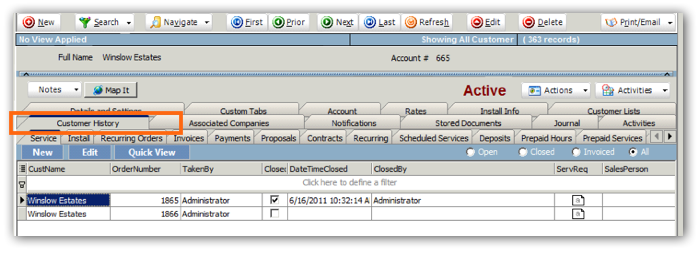
Service
On the Service tab you can access all service order history for the selected customer.
- Select an order and click Quick View to open the order in another window.
- Double click on the order to jump to the order in the Service Order module.
- Click on the column headers to sort orders.
- Drag and drop the column headers to change the column order.
- Right click on any order and select Export to Excel to open the data in Excel.
- Select Open, Closed, Invoiced or All to change the orders displayed based on the status selected.
Install
The Install tab is similar to the Service tab. The only difference is it lists Install Orders for the company selected. See instructions for Service above.
Recurring Orders
View all recurring orders for the customer. Set up new recurring orders in the Recurring Orders module, or by clicking New on this tab.
Invoices
- Access all invoices for the customer.
- Click on the column headers to sort by column.
- Select Open, Closed or All to change the invoices displayed based on the status selected.
- Select an invoice and click Quick View to open the invoice in a new window. This allows you to stay in the Customer module.
- Select an invoice and click Edit to jump to the invoice in the Invoicing module.
- Right click on any invoice and select Export to Excel to open data in Excel.
*NOTE* This tab may be hidden from your view based on permissions.
This tab may be hidden from your view based on permissions.
Click New Itemized Invoice – brings you to the Invoicing module with a new itemized invoice open for the customer. An itemized invoice isn’t linked to an order.
Click New Combined Invoice – brings you to the Invoicing module with a new combined invoice open for the customer.
Payments
On the Payments tab you can access all customer payment history. This tab may be hidden from your view based on permissions set by your SME Administrator.
- Select a payment and click Quick View to open the payment in another window. This keeps you in the Customer module.
- Click on the column headers to sort orders.
- Double click on the payment to jump to the payment in the Payment module.
- Drag and drop the column headers to change the column order.
- Select Payment, Credit or All to change the payments displayed based on the status selected.
- Right click on any payment, select Export to Excel to open the data in Excel.
Proposals
In the Proposals tab, you can access proposal history for your customer.
- Double click on the proposal to jump to the Proposal module.
- Select the proposal and click Quick View to open the proposal in a new window. This keeps you in the Customer module.
contacts
Access all maintenance contacts for your customer here. Click New to create a new Maintenance Contract for the customer or select a contract on the tab and click Edit to edit an existing contract.
Recurring
Access all recurring invoices for your customer in this tab. Click New to create a new recurring invoice or click Edit to edit an existing contract.
Deposits
To record deposits customers made
- Click New.
- Select how they paid in the Pay Type section.
- Fill out the Payment Amount and remaining fields.
- Click OK.
The deposit is recorded for the customer. You can see the Deposit on Account on the Account tab.
![]()
The deposit can be applied to invoices created for the customer. When creating an invoice for the customer, you will be prompted to type the amount of deposit you want to apply to an invoice (circled in image below)
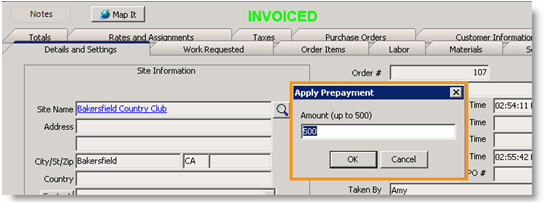
Item Repair
If a work order was created for the customer to repair some of their equipment, this tab will list the equipment to repair. Double click on the item and you can see what which equipment, the repair requested and repair performed.
Adding Columns to the tabs
If you want to add additional columns to the grids on the tabs under Customer History, you can right click in the grid on the tab and select Add Columns to Grid. In the window that opens, check the fields you want to view and click OK.
To go back to the original columns, right click in the grid and select Reset Grid.
If you select Clear Grid from the menu, all the columns will be hidden. You can click in the upper left corner of the grid to choose which individual columns to add back in (image below)

Associated Companies Tab
If you have parent/child relationships set-up between your companies, you can access this tab on the parent company to see all child companies. See the Details and Settings portion of this document to see how to set up parent-child relationship.
Notifications Tab
Set email or pop-up notification for your customer in this tab. Your SME Administrator will create the types of notifications that you can set for your customers.
Your administrator can select which modules these notifications are available for and what type of action taken prompts the notification (e.g. Adding, Editing, Deleting, or Closing the record in the customer module.)
1. On the Notifications tab, click New.
2. Select the Notification Type. If this drop down field is empty, your SME Administrator hasn’t set up any notifications for this module yet.
3. Check Send Email To and type the email address for the person that wants to be notified with activity for this customer.
4. Check Alert User to set a pop-up window to open when user and click Message. In the window that opens type the message you want your user to see.
**NOTE** if you don’t see the Notifications tab, then it was hidden from your view based on your user group permissions.
Move existing site to new billing company
If you are syncing SME with QuickBooks, see this video to move customers as job sites under another Billable or Parent customer. This would be done in the case that job sites are first imported into QuickBooks and then you need to move them as job sites. Do not move customers that have a history of invoices and payments.
<videoflash>ah7Nn6jUFlw</videoflash>
If you cannot move the site to a new billing customer in QuickBooks because of invoice and payment history, then you will need to create a new customer site and link it to the new billing/parent customer.
How to manage current orders/info and move to the new management company.
Company Names:
Old Billing / Management Company = D
New Billing / Management company = E
Old Site/Job/Customer = ABC (Change to ABC – D during the steps below)
New Site/Job/Customer = ABC – E
Actions:
- In QB
o Locate the ‘Site/Job/Customer’ under the current Management Company – ‘D’ parent
o Add a suffix to the name – ABC Site – D (makes this Site/Job/Customer unique)
o Sync – this will set the name in SME to ABC – D
- Create a new Customer in SME or QB called ‘ABC – E’ for the location – If in SME set the Billing to the ‘E’ parent
o Locate existing Recurring Orders or Invoices
o Click the Magnify glass next to the Site Name and browse for the new Site/Customer record.
o You can also move the customer equipment from ABC – D to ABC – E from the Customer Equipment module. (right click on the equipment and select "Move to another site)
Merge Customers
You can merge customer history from one customer into another customer in SME. Once the history is moved, the customer record you moved history from can be set to inactive.
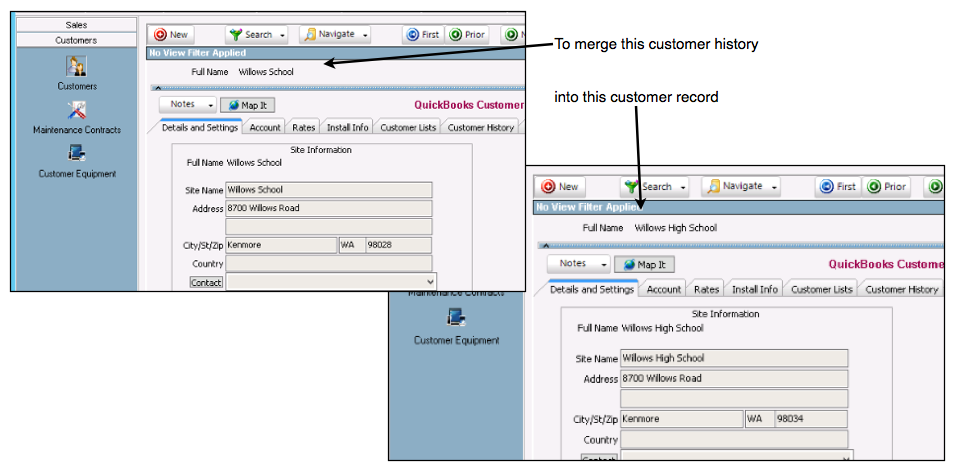
- Go to the customer you want to merge into another customer, click Actions > Merge with. (This is the customer you want to get rid of and merge history into another customer, in the image above it is Willows School.)
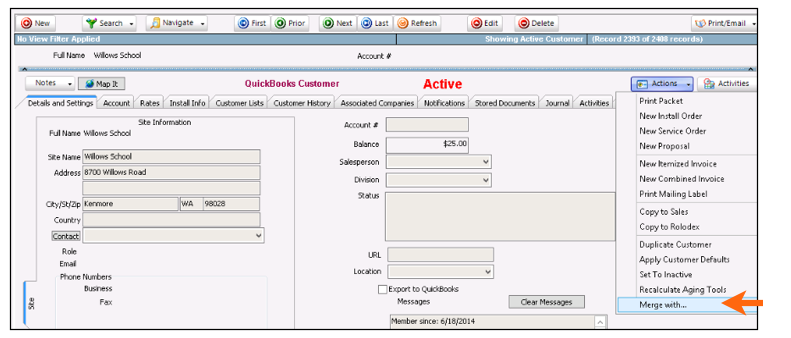
- In the search window that opens, select the customer you want to move the history to

- Your window will stay on the original customer. Check out the history tab and the service & install history should be empty. Set the Customer to inactive by clicking Actions > Set to Inactive and make sure Export to QuickBooks is unchecked. You could also delete the customer.
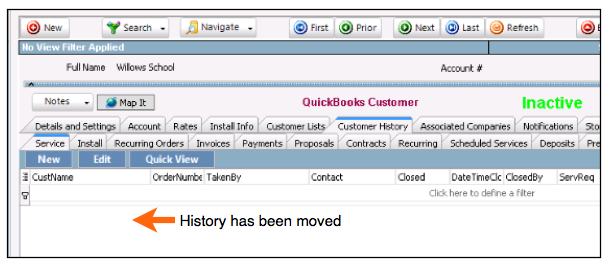
- Go to the other customer you merged history into
- Look at the history tab and you should see the orders from the other customer.
- If you want to update the name and address on the moved service orders that are still open, you can click propagate to orders from the site and billing tab on the customer you moved history to.
